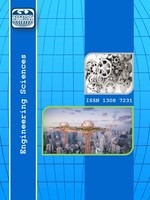COST AND QUALITY FOCUSED SUITABLE BOX DETERMINATION WITH DESIGN OF EXPERIMENT: A CASE OF A GLASSWARE COMPANY
Design of Experiment, DOE, 3k Full Factorial Design, Packing, Logistics, Cost
COST AND QUALITY FOCUSED SUITABLE BOX DETERMINATION WITH DESIGN OF EXPERIMENT: A CASE OF A GLASSWARE COMPANY
Design of Experiment, DOE, 3k Full Factorial Design, Packing, Logistics, Cost,
___
- [1] Layer, A., Brinke, E.T., Houten, F.V., Kals, H., and Haasis, S., (2002). Recent and Future Trends in Cost Estimation. International Journal of Computer Integrated Manufacturing, 15(6), 499-510.
- [2] Kuhn, H. and Sternbeck, M.G., (2013). Integrative Retail Logistics: An Exploratory Study. Operations Management Research, 6(1-2), 2-18.
- [3] Siepermann, C., (2007). Logistics Cost Accounting: Which System is Best Suited?. In Proceedings of the 12th International Symposium on Logistics (K.S. Pawar, C.S. Lalwani, M. Muffatto. ed.), Nottingham University Business School, Nottingham (pp:70-278).
- [4] Engblom, J., Solakivi, T., Töyli, J., and Ojala, L., (2012). Multiple-Method Analysis of Logistics Costs. International Journal of Production Economics, 137(1), 29-35.
- [5] Zeng, A.Z. and Rossetti, C., (2003). Developing a Framework for Evaluating the Logistics Costs in Global Sourcing Processes: An Implementation and Insights. International Journal of Physical Distribution & Logistics Management, 33(9), 785-803.
- [6] Weiyi, F. and Luming, Y., (2009). The Discussion of Target Cost Method in Logistics Cost Management. ISECS International Colloquium on Computing, Communication, Control, and Management, 537-540.
- [7] Havenga, J., (2010). Logistics Costs in South Africa–The Case for Macroeconomic Measurement. South African Journal of Economics, 78(4), 460-476.
- [8] Silva, T.F., Gonçalves, A.T., and Leite, M.S., (2014). Logistics Cost Management: Insights on Tools and Operations. International Journal of Logistics Systems and Management, 19(3), 329-346.
- [9] Churchill, G.A., (2002). Fundamentals of Experimental Design for cDNA Microarrays. Nature Genetics, 490–495.
- [10] Turley, L.W. and Milliman, R.E., (2000). Atmospheric Effects on Shopping Behavior: A Review of The Experimental Evidence. Journal of Business Research, 49(2), 193-211.
- [11] Wahdame, B., Candusso, D., François, X., Harel, F., Kauffmann, J.M., and Coquery, G., (2009). Design of Experiment Techniques for Fuel Cell Characterisation and Development. International Journal of Hydrogen Energy, 34(2), 967-980.
- [12] Shang, J.S., Li, S., and Tadikamalla, P., (2004). Operational Design of a Supply Chain System Using the Taguchi Method, Response Surface Methodology, Simulation, and Optimization. International Journal of Production Research, 42(18), 3823-3849.
- [13] Biehl, M., Prater, E., and Realff, M.J., (2005). Assessing Performance and Uncertainty in Developing Carpet Reverse Logistics Systems. Computers & Operations Research, 34(2), 443-463.
- [14] Manzini, R., Gamberi, M., Persona, A., and Regattieri, A., (2007). Design of a Class Based Storage Picker to Product Order Picking System. International Journal of Advance Manufacturing Technology, 32(7-8), 811–821.
- [15] Curcio, D. and Longo, F., (2009). Inventory and Internal Logistics Management as Critical Factors Affecting the Supply Chain Performances. International Journal of Simulation and Process Modelling, 5(4), 278-288.
- [16] Hussain, M., Drake, P. R., & Myung Lee, D., (2012). Quantifying the Impact of a Supply Chain's Design Parameters on the Bullwhip Effect Using Simulation and Taguchi Design of Experiments. International Journal of Physical Distribution & Logistics Management, 42(10), 947-968.
- [17] Cannella, S., Bruccoleri, M., and Framinan, J.M., (2016). Closed-Loop Supply Chains: What Reverse Logistics Factors Influence Performance?. International Journal of Production Economics, 175, 35-49.
- [18] Chackelson, C., Errasti, A., Ciprés, D., and Lahoz, F., (2013). Evaluating Order Picking Performance Trade-Offs by Configuring Main Operating Strategies in a Retail Distributor: A Design of Experiments Approach. International Journal of Production Research, 51(20), 6097-6109.
- [19] Van Hung, D., Nakano, Y., Tanaka, F., Hamanaka, D., and Uchino, T., (2010). Preserving the Strength of Corrugated Cardboard Under High Humidity Condition Using Nano-Sized Mists. Composites Science and Technology, 70(14), 2123-2127.
- [20] Carstens, R., (1992). U.S. Patent No. 5,085,367. Washington, DC: U.S. Patent and Trademark Office.
- [21] Büyüksaatçı, S., (2015). Bat Algorithm Application for the Single Row Facility Layout Problem. In Recent Advances in Swarm Intelligence and Evolutionary Computation (pp:101-120). Springer, Cham.
- [22] Montgomery, D.C., (2013). Design and Analysis of Experiments, 8th Edition. JohnWiley & Sons.
- Başlangıç: 2009
- Yayıncı: E-Journal of New World Sciences Academy
Hojjat GHAHRAMANZADEH ASL, Levent KARA, Yaşar SERT, Tugay SONSUZ SERT, Tevfik KÜÇÜKÖMEROĞLU
VEYN KESME DENEYİ İLE SİLTLİ ZEMİNLERİN KAYMA DAYANIMINA KİL YÜZDESİNİN ETKİSİNİN İNCELENMESİ
Esra TUĞRUL TUNÇ, Kürşat Esat ALYAMAÇ, Ragıp İNCE, Zülfü Çınar ULUCAN
Sinem BUYUKSAATCI KIRIS, Mesut SAMASTI, Ş. Alp BARAY
GRİ DÖKME DEMİRLERİN KATILAŞMA MODELLEMESİ VE GERÇEK DÖKÜMLER İLE KARŞILAŞTIRMASI
Murat ÇOLAK, İbrahim ARSLAN, Esma GAVGALI
DETERMINING THE BEST SUITABLE CONTROL STRATEGY OF THE VSC-HVDC FOR VOLTAGE STABILITY
TRAMVAYIN KAMPÜS YERLEŞKESİ İÇİNE ENTEGRASYONUNUN YAYA GÜVENLİĞİ AÇISINDAN DEĞERLENDİRİLMESİ
